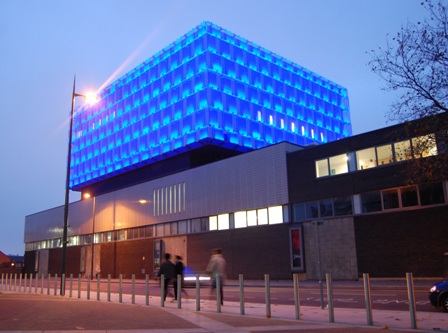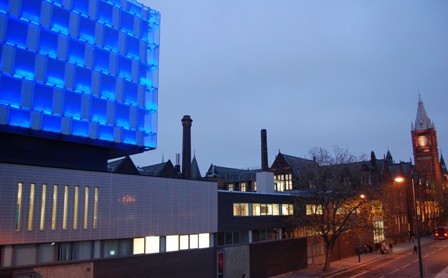The University of Liverpool’s Active Learning Laboratory, in the School of Engineering on Brownlow Hill, was illuminated in blue to mark World Diabetes Day, on Monday 14 November.
A disease with no known cure, diabetes affects around 200 million people worldwide and often requires treatment with drugs or the hormone, insulin.
But research at the University is pursuing a multitude of avenues to try and reduce the impact of this condition, whether through diet, neuroscience or studying the link between obesity and development of the disease.
Professor John Wilding, from the Institute of Ageing and Chronic Disease, has spoken at the Association for the Study of Obesity (ASO)’s London conference, on Diabetes and Obesity.
Professor Wilding said: “We carry out a lot of research related to diabetes and are currently involved in a project, funded by Diabetes UK, looking at patients’ attitude to weight change in relation to medication. Our main interest is trying to reduce the problems that people have in relation to diabetes and treat obesity, which is one of the major causes of diabetes.”
Dr Dan Cuthbertson from Obesity and Endocrinology, in conjunction with Dr Graham Kemp from Musculoskeletal Biology, is currently researching ‘fatty liver disease’, using the University’s unrivalled Magnetic Resonance and Image Analysis Research Centre (MARIARC) facility.
A high amount of liver fat increases the risk of developing diabetes and also makes the condition more difficult to control.
Dr Cuthbertson said: “We are looking with great precision at where fat is distributed and the health risks associated with that, in particular the adverse health effects of fat being deposited in the liver. Using these facilities at MARIARC we are able to carry out detailed body compositional analysis to get a great understanding of both the causes and consequences of obesity.”
The University’s reach in this area is global with academics working in African states including, Ethiopia and Malawi.
Professor Wilding said: “As countries start to become more westernised we are seeing a very large increase in diabetes, and healthcare systems are just not geared up to that.”
Past research connected to diabetes is broad and has explored a number of contributory factors including the neuroscience of palatability and taste, the psychological effects of cannabis in relation to appetite and the psychological aspects of appetite control.
Work is carried out across the University, with the key discovery of a sweet taste receptor in the intestines regulating capacity to absorb dietary sugars being made by Professor Soraya Shirazi-Beechey, from the School of Veterinary Sciences.
The Active Learning Laboratory is lit with hundreds of LEDs and can be seen as far away as Wirral. The facade of the building comprises 826 glass panels of which 413 panels are constructed from twin layers of glass, sandwiched with a dotted pattern. These translucent dots give a surface on to which light is reflected but also allow a direct passage of light through. The latest LED technology and electronic solar tracking equipment means the light display can be illuminated with the benefit of hugely reduced energy running costs.


I think this is a wonderful building, but must admit being confused initially. I drove past it thinking… I could have sworn it was green an moment ago !!!